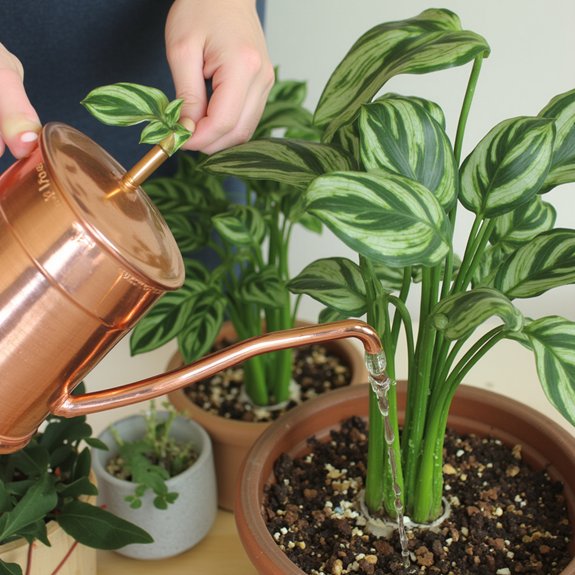Did you know that Philodendron Mamei can live over 20 years with proper care, yet most houseplant enthusiasts accidentally kill theirs within the first six months? You’re about to discover why this stunning “Silver Cloud” philodendron has earned its reputation as both a coveted collector’s prize and a surprisingly finicky houseplant. The secret lies in understanding its unique tropical origins and translating those conditions into your home environment.
Contents
- 1 Understanding the Silver Cloud Philodendron: Origins and Characteristics
- 2 Creating the Perfect Growing Environment for Your Philodendron Mamei
- 3 Watering Techniques and Soil Requirements for Optimal Health
- 4 Light, Temperature, and Humidity Management
- 5 Feeding Your Plant: Fertilization Guidelines and Seasonal Care
- 6 Propagation Methods and Repotting Best Practices
- 7 Troubleshooting Common Issues and Pest Management
Understanding the Silver Cloud Philodendron: Origins and Characteristics

Discovery led to one of today’s most sought-after houseplants when explorers found Philodendron mamei in Ecuador’s rainforests during the late 1800s. You’ll appreciate its fascinating Philodendron history, which began with the genus discovery in the 1600s, though formal plant classification didn’t occur until 1829. The name literally means “tree hugger,” reflecting its natural climbing behavior.
Initially classified as terrestrial, scientists later reclassified it as epiphytic. You’ll recognize this Silver Cloud Philodendron by its heart-shaped leaves featuring striking silver markings, deep veins creating a ridged appearance, and bushy growth from dark green stems with distinctive red bases.
Creating the Perfect Growing Environment for Your Philodendron Mamei
When you’re setting up the ideal environment for your Philodendron mamei, light becomes your first priority. Position it near a window with bright, indirect sunlight, avoiding harsh direct rays that’ll scorch those beautiful silver markings.
Temperature control matters too. Keep your plant comfortable between 65°F and 85°F, away from drafty windows and heating vents.
Creating humidity above 50% keeps your mamei thriving. Try misting, grouping plants together, or using a humidifier for best results.
For ideal potting, mix two parts potting soil, one part perlite, and one part coconut husk. This combination provides excellent drainage while retaining just enough moisture.
Watering Techniques and Soil Requirements for Optimal Health

Although watering seems straightforward, your Philodendron mamei’s health depends on getting the timing and technique just right. Check the top 2 inches of soil before watering—when they’re dry, it’s time. Your watering frequency should increase during summer months, but always avoid soggy conditions.
Proper soil composition makes all the difference. Mix 2 parts potting soil, 1 part perlite, and 1 part coconut husk for ideal drainage. Never use garden soil, as it retains too much moisture and leads to root rot. This well-draining blend prevents waterlogged roots while maintaining necessary moisture levels for healthy growth.
Light, Temperature, and Humidity Management
Your Philodendron mamei’s stunning silver variegation depends entirely on receiving the right light conditions. Place it near a north or east-facing window for bright, indirect light exposure. Direct sunlight will scorch those beautiful leaves, fading the silver markings you love.
Temperature stability matters tremendously. Keep your plant between 65°F and 85°F year-round. Avoid placing it near heating vents, air conditioners, or drafty windows that create sudden temperature swings.
Humidity levels need consistent attention since this tropical native craves at least 50% humidity. Use a humidifier, group plants together, or place it on a pebble tray.
Feeding Your Plant: Fertilization Guidelines and Seasonal Care

Since Philodendron mamei grows actively during spring and summer, it needs regular feeding to maintain those gorgeous silver markings. You’ll want to fertilize every other month during these peak growing seasons using a balanced liquid fertilizer.
Different fertilizer types work well, but stick with balanced formulations that won’t burn the roots. Always follow the package instructions carefully, as overfertilization can damage your plant.
Seasonal adjustments are essential for success. Stop feeding completely during fall and winter when growth slows down. Your plant enters a rest period and doesn’t need extra nutrients during these months.
Propagation Methods and Repotting Best Practices
Once you’ve mastered feeding schedules, you’ll likely want to expand your Philodendron mamei collection through propagation. Stem cuttings offer the easiest method, requiring clean, sterile tools due to the plant’s toxicity. Cut 4-6 inch sections with nodes, then root in water or moist soil.
Air layering provides another reliable option for larger specimens. Wrap damp sphagnum moss around a node, cover with plastic, and wait for roots to develop.
For repotting, spring timing works best when roots emerge from drainage holes. Choose a slightly larger pot, use well-draining soil, and water immediately to prevent transplant shock.
Troubleshooting Common Issues and Pest Management
While Philodendron mamei ranks among the easier houseplants to maintain, you’ll occasionally encounter issues that need quick attention. Pest identification becomes essential when dealing with spider mites, scale, or mealybugs. Apply neem oil directly to affected areas, repeating weekly until pests disappear.
Leaf discoloration signals underlying problems requiring immediate action. Yellow leaves typically indicate overwatering or nutrient deficiency, while brown, crispy edges suggest underwatering or low humidity. Check soil moisture levels first, then adjust your watering schedule accordingly.
Fungus gnats thrive in overly moist soil. Place sticky traps near the plant base and reduce watering frequency until the top two inches dry completely.
